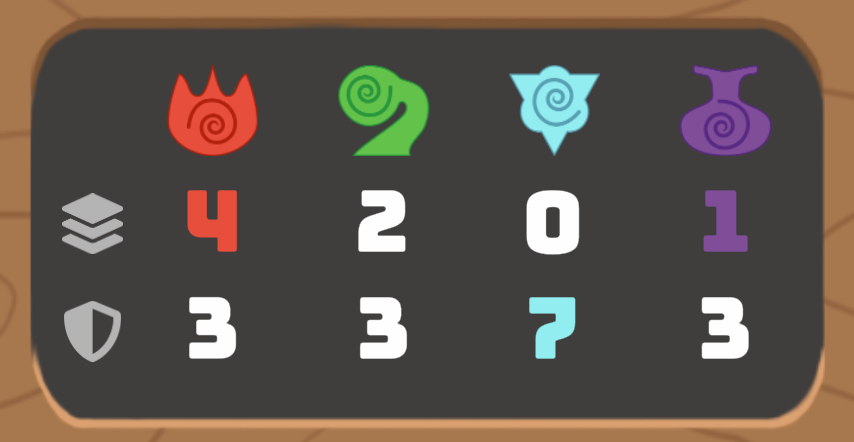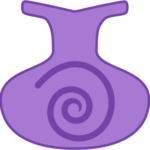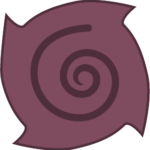There are 5 types of regular dice elements: Normal, Fire, Nature, Frost, and Poison. All of these, except Normal, can both inflict and protect against their associated debuffs.
Stack and resistance #

The infliction of debuffs is determined by a character’s stack and resistance to that element. For the player, you’ll see these values to the right of the shield on the dice tray (pictured). You can see an enemy’s elemental statuses beneath their health bar. Near the end of each round, both the player and enemies’ stacks of all elements reduce by their matching resistance values.
Attacking with elemental dice (besides normal) raises that element’s stack. The stack equaling or exceeding the resistance inflicts the debuff, which will persist until the stack reaches 0 again. A coloured stack value indicates that the debuff is active.
Blocking with elemental dice (besides normal) raises the resistance to that element. This means it will take more stack to actually inflict the debuff. Additionally, increased resistances mean their stacks will reduce by more at the end of a round. Just like block, resistances get reset at the end of a round, so this additional defence is only temporary. A coloured resistance value indicates that it has been increased via blocking or other means.
In the image above, you can see that the player is both burnt and poisoned. Notice that the poison stack value is lower than the poison resistance; this is because the resistance or damage has already reduced the stack, but it remains above 0, meaning the debuff has persisted. This player has also buffed their frost resistance, indicated by its resistance value being a different colour.
Ending a battle, either by winning or fleeing, causes all stacks and resistances to reset, and will remove all debuffs. Don’t worry about ending a battle with an array of maladies – you’ll be back to normal in the next fight.
Complete stacks #
An important concept when learning the elements system is called complete stacks. This refers to when your stack becomes a multiple of your resistance. For example, if you have 6 stack and 3 resistance, we’d say you have 2 complete stacks of that debuff. Every element uses this system when determining the severity of its effects; the more complete stacks you have, the worse-off you’ll be.
As a result, you’re able to mitigate every debuff by raising its corresponding resistance and skewing the ratio. With the above example of 6 stack and 3 resistance, if you raised your resistance by any amount through blocking or other means, you’d no longer have 2 complete stacks, thus reducing the severity of the debuff. Once you have a debuff, however, you can’t completely remove it simply by raising your resistance – it will only disappear once the stack reaches 0 again, even if the stack becomes lower than your resistance.
List of elements #
Normal #

Most characters start with at least one normal die. There’s really nothing remarkable about them; they just deal and block damage with no additional effects. The main benefit to them is they’re much, much cheaper to upgrade than dice of other elements. You may be able to garner some hefty numbers with them, especially with certain tricks. Normal dice are also a common requirement in many gambits, and they interact with holy and necro powers from altars.
Fire (Burn) #

Fire dice can inflict the Burn debuff. A burnt character will receive extra damage from dice attacks, dealing a minimum of 1 bonus damage.
The amount of burn damage you take is equal to the number of complete stacks you have (explained above). However, the burn damage won’t exceed the value of the die that triggered it. For example, hitting an enemy with a 7-value die while they have 2 complete burn stacks will only deal 2 additional damage. Increase their stack enough, and you can hit up to 7 with that same die.
Burn damage counts as a separate hit, and therefore does not increase stack damage you inflict with other elements. This means hitting a burnt enemy with a 4-value nature die will still inflict 4 wither stack, despite dealing 4 plus another 1-4 damage, depending on their stack.
Another important thing to note is that burn bonus damage will reduce the burn stack once it hits. This reduction is equal to the amount of bonus damage inflicted. This means you’ll whittle down a heavily-burnt opponent’s stack much quicker, as you’ll be inflicting more damage per die. This will also happen with fire dice, effectively capping the amount of burn stack that can be inflicted.
Nature (Wither) #

Nature dice can inflict the Wither debuff. A withered character will deal less damage with dice attacks, with a minimum penalty of -1 per die.
The amount of the penalty is equal to the number of complete stacks you have (explained above). For example, with 2 complete stacks, my 7-value die will only deal 5 damage. As such, with a high enough stack (or low enough dice values), it’s possible for withered dice to deal 0 damage. In such cases, this still counts as an attack, so you may need to be careful of certain enemy abilities and burn damage, which always trigger on attacks.
Unlike burn, the wither penalty does apply to the stack damage a die can inflict with other elements, making wither an excellent option for mitigating or outright nullifying an enemy assault. Conversely, you’ll always need to make sure you factor in wither when planning out your attacks, lest that debuff you were about to inflict to save the run ends up just missing the mark.
You can reduce your wither stack by attacking with dice. The amount it reduces your stack is equal to the penalty the die received, so with a high stack, you can either chip away at the penalty with several low-value dice or remove a big chunk with a single high-value one. Nature dice are not affected by wither, so attacking with them will not incur a damage penalty. However, as a result, they will not reduce your stack when used to attack – you’ll have to decide when it’s best to keep attacking or to buff up your resistance.
Frost (Freeze) #

Frost dice can inflict the Freeze debuff. When triggered, one or more dice will become frozen, and cannot be rolled or used to attack until they thaw. Frozen dice are instead forcibly allocated to block.
Freeze will prioritise freezing dice allocated to attack; this is true for both the player and enemies. If there are no attack dice, freeze will target a block die instead. Specific enemies later on can allocate their dice to heal, in which case, heal dice will be frozen between attack and block dice. If there are multiple candidates for freezing, the lowest value die will freeze first. Further ties are broken by elements (normal/holy/necro > poison > nature > fire), and if there’s still a tie, it’ll be determined randomly.
Freezing an enemy’s attack die immediately moves it over to block, as though they allocated it there from the start. As a result, it’s best to deal damage to them with your other dice first before freezing them, or you may lose out on some health damage. Freeze works a little differently for you: in the next round, you simply won’t be able to allocate your frozen dice directly, and it’ll be locked to whatever result it rolled when it got frozen. Don’t panic too much though, as ending your turn will auto-allocate any frozen dice in your tray to block.
Multiple dice can be frozen at once if a character has more than 1 complete stack (explained above). This means that a character’s stack becomes a multiple of their resistance; for example, with 3 freeze resistance, 6 frost damage will freeze 2 dice. Raising freeze resistance by blocking with frost dice can change the amount of complete stacks you have; in the same example, blocking with a 2-value frost die will raise freeze resistance to 5. This means there’s only one complete stack, causing one frozen die to thaw and immediately become usable again.
Unlike debuffs from other elements, freeze only lasts for one round, but it can be a real lifesaver in a pinch. Be sure to use it wisely.
Additionally, just like wither with nature dice, frost dice cannot get frozen. You may want to invest in a couple if your resistance is particularly low.
Poison (Poison) #

Poison can inflict the – you guessed it – Poison debuff. While poisoned, a character will receive damage based on the number of complete stacks they have (explained above); with 3 poison resistance and a stack of 4, there’ll be 1 poison damage incoming. With the same resistance, if you then end up with a stack of 9, you’ll receive 3 poison damage.
Because poison damage is based off complete stacks, it’s possible to mitigate it by raising your poison resistance. With a stack of 9 and resistance of 3, blocking with a 4-value poison die will raise resistance to 7. That’s only 1 complete stack, which equates to 1 poison damage.
When you compare this to burn, it doesn’t seem like a huge deal. However, the critical difference is that poison is unblockable, damaging health directly. Consequently, there’s no way to avoid taking at least 1 poison damage. Naturally, this means it’s an excellent way to deal with block-happy enemies.
Poison damage is dealt right after you end your turn – we refer to this as the poison damage phase. One thing to note about this is that enemies will take poison damage before you, so if you’re in an all-out biohazardous war of attrition and everyone’s about to die from poison damage, you’ll end up victorious.
Somewhat similar to burn, taking poison damage will reduce your stack, but only by half the amount of damage it deals. With the previous example of a stack of 9 and resistance of 3, you’d take 3 damage and your stack would get reduced by 1 (as the reduction rounds down). This occurs in addition to the regular stack reduction at the end of the round, so you’d start your next turn with a stack of 5.
Holy and Necro #


Holy and necro dice are distinct from all other dice elements. For the most part, you’ll only be able to acquire these by aligning one of your dice at an altar.
You can’t upgrade these dice at the forge, nor is there any debuff associated with them. In terms of attacking and blocking, they are identical to normal dice. You can also use them in place of normal dice in gambit slots that require that element.
You generally won’t be able to have a necro and holy die at the same time, and having more than one of either is exceptionally difficult.
However, each of these unique elements provides a special power if you’re able to store enough energy in battles. To read more about them, visit the altar article.
